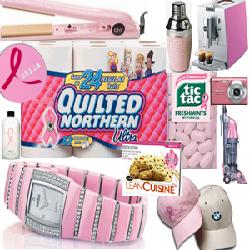
The referenced media source is missing and needs to be re-embedded.
By Madeleine Doggett, Massachusetts Intern
One in eight women will be diagnosed with breast cancer in the U.S. in her lifetime—that is 250,000 women each year. Every year 40,000 women die from breast cancer in the U.S. Breast cancer is an epidemic and the disease needs to be stopped before it starts. October is national breast cancer awareness month, which means pink ribbons as far as the eye can see, but how much are these pink ribbons really helping the cause? Since the national pink ribbon campaign began, have breast cancer rates decreased at all?
The first breast cancer ribbon was peach, not pink, made by a woman named Charlotte Haley to campaign for the National Cancer Institute to increase funding for breast cancer prevention research. Haley was approached by Estee Lauder to use the peach ribbon to market cosmetic products, but Haley refused, fearing that the ribbon would be used for profit. That is when Estee Lauder changed the color to pink and the national marketing campaign began. The pink ribbon can now be found on an array of products, but consumers should be aware that there is no regulation of which products can advertise with a pink ribbon. In fact, many corporations are selling pink ribbon products which themselves contain chemicals linked to cancer, a marketing ploy referred to by some as “pinkwashing.” There are 80,000 toxic chemicals produced in the U.S. every year, of which only 200 have been properly tested for human safety.
Breast cancer rates have significantly increased over the last century. In 1920 only one in twenty women was diagnosed with breast cancer in her lifetime (compared with the current one in eight). Breast cancer research has mostly focused on treatments and cures for woman already diagnosed, which is important, but leaves out the important angle of preventing women (and men) from getting the disease in the first place. Of the $1.5 billion dollars spent every year on breast cancer research, only 7% goes towards prevention. The strategy of waiting until people get sick and searching for treatments, rather than addressing the root causes, results in much suffering that could be avoided.
Clean Water Action works with the Alliance for a Healthy Tomorrow (AHT) coalition to create laws and policies that prevent harm to our health from toxic chemicals. Our partners in the AHT include groups who are doing important work to shift the focus of the national breast cancer campaign towards prevention. Massachusetts Breast Cancer Coalition, which is a founding member, board member and lead partner of AHT has started the campaign Turn Pinkwashing into Prevention to raise awareness about the environmental carcinogens woman are exposed to everyday. By encouraging companies to remove chemicals linked to breast cancer from their products and by raising consumer consciousness of pink ribbon products they are taking important steps in the fight towards prevention.Another AHT member group Breast Cancer Action is doing similar work on a national level with their Think before you pink campaign.
October’s pinkwashing can serve as a reminder that the links between toxic chemical exposure and breast cancer incidence are largely swept under the rug by manufacturers of consumer products. We need stronger state and federal laws that hold companies accountable for the toxic chemicals that they use and require companies to phase toxic chemicals out in favor of safer alternatives wherever possible.
Information for this article was drawn from the websites and materials of the Massachusetts Breast Cancer Coalition and Breast Cancer Action.Related Posts
Stay Informed
Get the latest updates and actions:
Thanks for signing up!
There was a problem processing your signup. Please try again.


